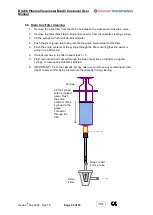
BV200 Plasma Viscometer Mk2/3 Customer User
Manual
Issue 9
th
Sep 2020 - Rev 1.8
Page 52 of 53
11. Plasma Viscosity Clinical Interpretation
Plasma viscosity changes when plasma protein concentrations are altered. The major influences
on plasma viscosity are exerted by fibrinogen and immunoglobulins. Fibrinogen responds as an
acute phase reactant and is raised in the initial stages of any inflammatory response. In infection,
the initial response is followed by an increase in immunoglobulin which will maintain a high
plasma viscosity.
In some autoimmune conditions e.g. rheumatoid disease, the increased immunoglobulins, along
with the raised fibrinogen due to the inflammatory response, can produce a raised plasma
viscosity.
In early tumour growth, normal plasma proteins and plasma viscosity are seen. When the tumour
becomes invasive or disseminated, a rise in plasma viscosity is frequently seen.
Conditions that secrete paraproteins e.g. myeloma or macroglobulinaemia are associated with
very high plasma viscosity. Untreated myeloma plasma frequently has viscosity values of >3
mPa.s while plasma containing macroglobulins can have values >10 mPa.s.
11.1.
Samples Required
Plasma from EDTA anticoagulated peripheralvenous blood.
11.2.
Sample Storage and Preparation
Centrifuge sample at 3500 rpm for 10 minutes, 2000g for 10 minutes, 3000g for 5 minutes or
equivalent.
Samples can be stored at ambient room temperature (15°C-20°C) for up to 7 days.
It is recommended that the plasma is taken off the red cell fraction if practical.
11.3.
Interpretation of Results
Normal Range
1.50
– 1.72 mPa.s
Low results
<1.50
Found in infants under 3 years old and patients
with low immunoglobulin or fibrinogen levels.
Equivocal
Results
1.72-1.75
Frequently found not to be of clinical significance.
If investigating a clinical condition suggest
discussing with clinician and repeat after
appropriate time.
If found by chance discuss with clinician and
suggest monitor patient
High results
1.75
– 2.00
Found in many chronic disorders e.g.
Autoimmune diseases infection, malignancy,
vascular disease and other causes of
inflammation.
Very high results 2.01
– 3.00
Suggestive of myeloma.
Extremely high
results
>3.00
Suggestive of Waldenstrom‟s
macroglobulinaemia.


































